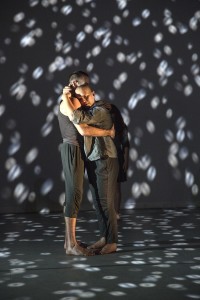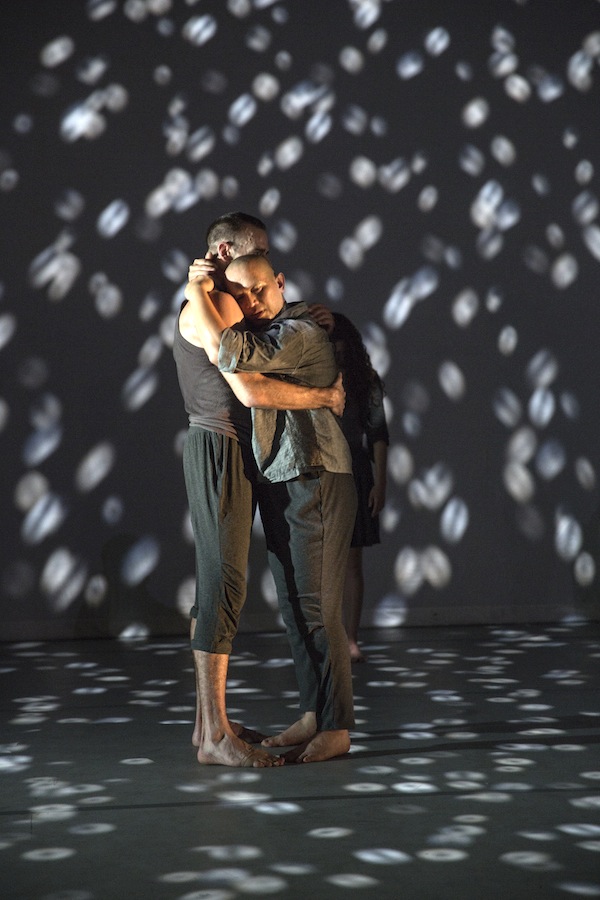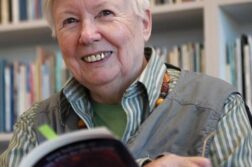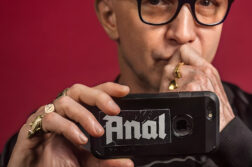DAVID ROUSSEVE is artistic director and choreographer of Reality, a dance theater company that has toured extensively throughout the U.S., Europe, and South America. In addition, Roussève is professor of choreography at UCLA’s Department of World Arts and Cultures/Dance, where he has taught since 1996.
 Roussève is known for his highly original form of expressionistic dance theater that blends elements of dance and performance art with African-American traditional and pop cultures. As artistic director of Reality he has created thirteen full-length works to date. The latest is a work called Stardust, which explores the evolving nature of intimacy in our fast-paced, high-technology world. This summer, Stardust will be coming to Jacob’s Pillow, the dance festival in western Massachusetts, from August 6 to 10. This is “Out Weekend,” a new Pillow tradition of which the GLR is a sponsor.
Roussève is known for his highly original form of expressionistic dance theater that blends elements of dance and performance art with African-American traditional and pop cultures. As artistic director of Reality he has created thirteen full-length works to date. The latest is a work called Stardust, which explores the evolving nature of intimacy in our fast-paced, high-technology world. This summer, Stardust will be coming to Jacob’s Pillow, the dance festival in western Massachusetts, from August 6 to 10. This is “Out Weekend,” a new Pillow tradition of which the GLR is a sponsor.
This interview was conducted by the GLR editor by phone in late April.
Gay & Lesbian Review: Your latest production, Stardust, will be at Jacob’s Pillow this summer. I’ll be there, but so far I’ve seen only snippets on YouTube. But it looks like an amazing piece. It’s the story of an African-American teenage boy who’s struggling with being gay and alone, and it’s told through dance, but also through text messages and other images that appear on a screen, such as a striking close-up of a bird in flight. So what’s going on?
David Roussève: For sure. It is an amalgam of so many different elements, some of them technology-produced. But the idea is that we never see this main character, who is this young adolescent, gay, African-American boy who feels ostracized from the larger community, but also from his African-American community because he’s gay. We get to know his story through a series of text messages that he’s sending. He identifies in those text messages that he’s kind of theatrical. The audience can see that he’s sending them to an unassigned number, just to get his story out there.
The overall framework for the evening is that the little boy’s narrative is told through the text messages, but his emotional terrain—being inside of his head, or maybe inside of his heart: how he feels as opposed to how he behaves. But that kind of emotional life is told through the dancing. The ability of dance to speak through this emotional metaphoric language and then, combined with that, there are these surreal visual images that augment that visual terrain, which are meant to be his imagination. And then the last element is that the music of the piece jumps back and forth between Nat King Cole, as this quintessentially romantic and intimate music of his grandfather’s world that the boy has come to love, and this original, more driving and forceful, contemporary but hip-hop infused music that a composer named d. Sabela grimes wrote for the piece.
GLR: Most of what I saw was the latter kind of music. I didn’t hear any of the Nat King Cole. But that’s an interesting contrast!
DR: Yeah, there are these amazing Nat King Cole standards: When I Fall in Love, Mona Lisa, just on and on. One of the really fabulous things about the piece has been dancing to Nat King Cole. However, getting rights to the music has not been easy, and that’s why you didn’t see it on the video.
GLR: Interesting. Would you say that this piece is typical of your work, or is it quite different? Are the pieces interconnected at all—are there recurring themes?
DR: I think this one is very different. This is the thirteenth full-length piece for my own company. I also do commissions for other companies. But this one really sticks out in that it has no spoken text. Usually there is in my work: usually the dancers speak as well as move. Here all the text is projected. One reason we’re not speaking in this piece is that this piece probably has more kinetically forceful movement in it than any piece I’ve played from my own company.
Also, I wanted to work with technology in a meaningful way in the piece, and see if it can be a part of an intimate and sometimes even spiritual conversation. The jumping-off point for the piece way back when, when it very first started, was in fact the conversation between intimacy and technology and how the one affects the other in the contemporary world. And I think that theme, as well as the technological component to the piece, really distinguishes it from my other work.
GLR: You mentioned that there is often some vocalization in the dialogue, which is unusual for modern dance. It almost seems like there’s an unwritten rule that the dancers never speak. I saw on YouTube a snippet of Saudade, which has a storyteller figure.
DR: Yes, that was me, actually. I had long dreadlocks then; but now, not so much.
GLR: So this is part of your style, to include the spoken word, integrated with the dancing. Does your background include literary training as well as dance?
DR: Yeah, because I actually started in theater before dance, as a child back in Houston, which is where I’m from—but mostly commercial, really bad children’s theater. Then I was an undergrad—I did my undergrad work at Princeton, where I was pre-law. That was where I discovered that I wanted to do something meaningful with my life. And what I discovered was that dance and theater actually could create the dialogues that are contributing something, or creating conversations between communities. That was what I discovered as an undergrad, and then continued in New York.
Part of that dialogue was that it would be grounded in dance, but literally be a dialogue that involved words. And so the power of words to deliver specific narratives in ways that perhaps movement can’t became really important to me, even as the power of dance to communicate emotionally and deeply through a metaphoric language became more and more important to the work.
So traditionally it’s been that combination of telling the stories of off-beat characters or maybe making the protagonist someone that we might not necessarily think of as such, like a thirteen-year-old queer boy from South Central L.A. And words have traditionally been an important part of that dialogue, and the fusion of words and movement.
What happened with Stardust is that I really wanted to keep just as many words, but not have the live delivery of the words interfere with the full-throttle dancing. There is actually one monolog that survived. Kevin delivers it as a very serious monolog, but it’s a comedic point in the show. But he delivers it as a straight poetic monolog.
GLR: So, are your influences then literary? Where do you get ideas for your stories?
DR: In the early days and actually almost up until Stardust, they were autobiographical or biographical, meaning about myself or my family. I did a series, five folding pieces, using my grandmother’s narrative as a backwoods bayou woman, a Creole woman from the swamps of Louisiana—her plight as a woman of color. I used those familial autobiographical stories as the spine of the piece. And often I would use my own autobiographical stories.
When they haven’t been autobiographical, they’ve been personal. At the apex of the AIDS pandemic, I created a fictional character who was this African-American man who was dying of AIDS, and his plight, and the ostracism that he was going through. It was kind of reflecting all the different communities that I was in, how we were also involved with and devastated by AIDS. In Stardust, the main character is named Junior, and I set out to write a completely fictional story.
GLR: So Stardust is not autobiographical.
DR: It is not. But what I discovered is that the truth of his story felt more familiar, rang truer to me than even some of the autobiographical narratives. I think having the distance of saying this is a fictional character allowed me to invest more of myself in that character, interestingly. The distance became an asset for creating closeness.
GLR: In discussions of your work, a word that comes up a lot is “fusion.” It’s characterized by a lot of musical genres—jazz, hip-hop, Nat King Cole—and there are elements of performance art as well as modern dance. Do you think fusion is a good word for it?
DR: I think one of the things that makes the work interesting is that the compositional package or shape of it, the architecture, is definitely interdisciplinary, contemporary, post “modern dance.” It’s experimental in shape in that the fusion of music, dance, and the spoken word is more important to the work than any of these elements on its own. But the irony of the piece is that its structure is closer to dance theater, maybe more akin to Pina Bausch than urban America.
However, the culture of the piece and the language that it talks to is still decidedly African-American, so the language and the music and the accessibility of the work are all derived from my own African-American culture. So what you get is this kind of experimental interdisciplinary dance theater, but that’s grounded in an urban pop sensibility, an African-American pop sensibility.
And complicating things further is the very strong gay sensibility that’s infused into the work thematically, which has traditionally been something of a challenge to the African-American community. So while I think of it as a fusion of elements that lends an accessibility to the work, sometimes it can feel like it’s too avant-garde for the mainstream community, too gay for the African-American community, too African-American for the dance community. So it’s an interesting balance of elements.
GLR: You’ve been successful in showing your work all over the world, so it seems you’ve managed to find an audience.
DR: Yeah, it’s actually been very inspiring. One of the challenges with Stardust is that I really tried to keep the work accessible. And I think the narrative really helps. It gives you an entrée into the work. There’s a spiritual conversation at the core of Stardust, which is actually aimed at the African-American spiritual community, which is about this boy, who is a bad-ass—I mean, he’s violent. But he’s really decent and good at heart, and yet he feels completely ostracized from his churchgoing, African-American community because he’s gay. And that was definitely a risk, because we hoped to bring in the churchgoing African-American community. So Stardust is the boldest attempt that we’ve made yet to create connective tissue or bridges between communities, because the issues are most certainly a challenge, and could be taken as an affront, to the different communities.
GLR: Is that because that the African-American community has been less welcoming?
DR: Yeah. Three years ago, when we started making Stardust, I realized that there’s this core theme of this boy trying to reclaim both his humanity and also his, for lack of a better way to put it, his spiritual dignity. And what I realized as I started writing and the character and his narrative started to emerge was that I am affronted by the religious community, and certainly the African-American religious community, when they say that being gay is a sin. I think what I actually heard as a child was: God does not love you. And to me, that’s the biggest affront in both a political and a spiritual way. So Stardust wanted to address that issue, and that’s at the core of what this boy is saying: I feel ostracized, and there’s a community that should be loving me. He’s also on a more universal journey of growth and acceptance. It’s a coming-of-age story that’s complicated by the fact that he’s African-American and gay.
GLR: What’s the significance of the name?
DR: It’s the only name that we’ve never changed. It actually came about when we first started in the 80s, and the company was composed of me and twelve incredibly fierce women, and we had no other men in the company. And what happened was, we thought that it had a dual meaning: our work was steeped in a whopping dose of reality, and the real world brought to dance. It sounded like a cute girl-group name, like the Supremes.
GLR: Let me ask you about Jacob’s Pillow, You’ll be there in early August during Out Weekend, of which the GLR is a sponsor.
DR: Ah, fabulous. Jacob’s Pillow, it’s one
of the places on the planet that you’ve just heard all these amazing things about, and when you finally get there, you’re not disappointed. I thought it was phenomenally beautiful, and they’ve established such an incredible atmosphere there, as far as viewing performance in an incredibly peaceful and tranquil setting.
It’s so interesting that you mentioned this because I adore [Jacob’s Pillow executive director] Ella Baff. Ella was one of the first presenters when she was at Cal Performances in Berkeley, and she presented my work way back in ’92, so she and I have had a very long ongoing conversation. And she’s very supportive. My impression of the last time we were at Jacob’s Pillow was that Ella completely supported our coming there. The work was very adventurous, definitely pushing new boundaries at Jacob’s Pillow.





